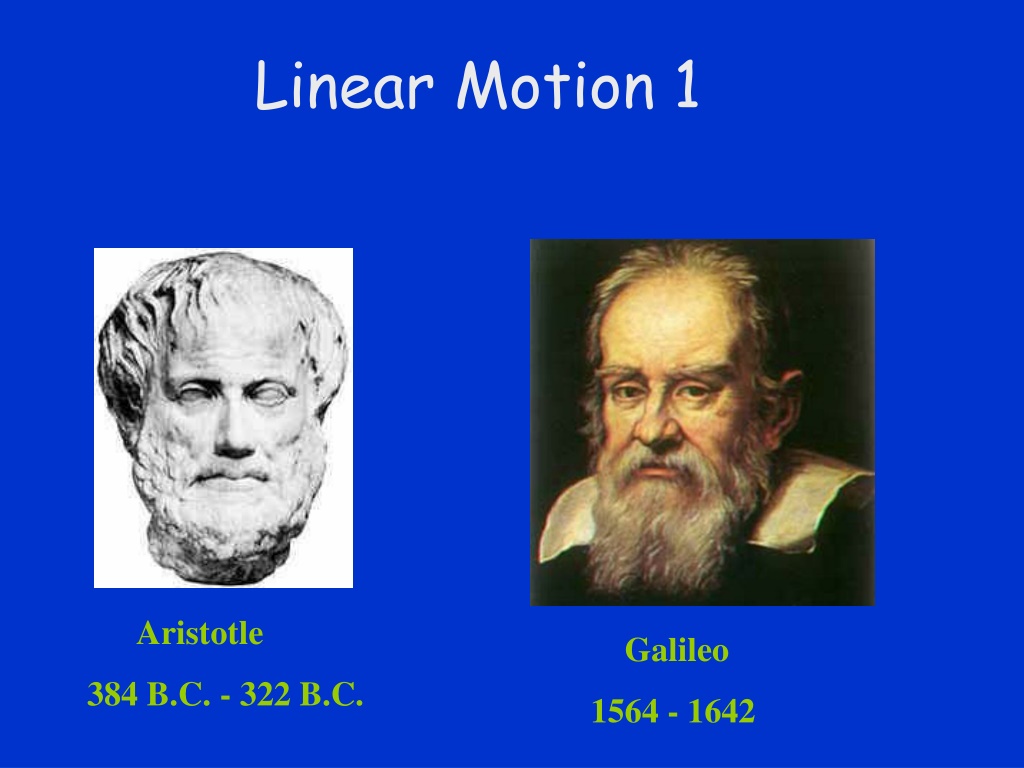Understanding Linear Motion in Physics
Explore the concepts of linear motion in physics through the teachings of Aristotle and Galileo. Learn about scalars and vectors, distance versus displacement, examples of displacement calculations, and speed versus velocity distinctions. Engage in conceptual tests to deepen your understanding of the principles governing motion in the physical world.
Download Presentation

Please find below an Image/Link to download the presentation.
The content on the website is provided AS IS for your information and personal use only. It may not be sold, licensed, or shared on other websites without obtaining consent from the author. Download presentation by click this link. If you encounter any issues during the download, it is possible that the publisher has removed the file from their server.
E N D
Presentation Transcript
Linear Motion 1 Aristotle Galileo 384 B.C. - 322 B.C. 1564 - 1642
Scalars and Vectors The motion of objects can be described by words such as distance, displacement, speed, velocity, and acceleration. Scalars Vectors
Scalars & Vectors Scalars: fully described by magnitude (or size) alone. That is, direction is not involved. o distance, speed, mass, temperature o 3m, 5 m/s, 60 kg, 5oC Vectors are quantities fully described by both magnitude (size) and direction. o displacement, velocity o 3m, right; 5 blocks south; -2 m (the sign is the direction); 2 m/s, up
Distance and Displacement Distance is a scalar quantity referring to how far an object or person has traveled. It is the reading on a pedometer or on an odometer. Displacement is a vector quantity referring to the object's change in position. Displacement is calculated by subtracting the initial position from the final position: Xfinal - Xinitial
Displacement Example A physics teacher walks 4 meters East, 2 meters South, 4 meters West, and finally 2 meters North. The physics teacher has walked a total distance of 2 m + 4 m + 2 m + 4 m = 12 m The physics teacher s displacement is 0 m
Concept Test #1 A person initially at point P in the illustration stays there a moment and then moves along the axis to Q and stays there a moment. She then runs quickly to R, stays there a moment, and then strolls slowly back to P. Which of the position vs. time graphs below correctly represents this motion?
Concept Test #2 An object goes from one point in space to another. After it arrives at its destination, its displacement is: 1. either greater than or equal to 2. always greater than 3. always equal to 4. either smaller than or equal to 5. always smaller than 6. either smaller or larger than the distance it traveled.
Speed and Velocity Speed is a scalar quantity referring to how fast an object is moving. Direction is irrelevant. Velocity is a vector quantity referring to how fast an object changes its position. Imagine a person moving rapidly - one step forward and one step back - always returning to the original starting position. This motion results in zero average velocity.
Velocity & Speed The physics teacher walks 4 meters East, 2 meters South, 4 meters West, and finally 2 meters North. The entire motion lasts 24 seconds. Determine her average speed and average velocity. The physics teacher walked a distance of 12 meters in 24 seconds; thus, her average speed was 0.50 m/s. However, since her displacement is 0 meters, her average velocity is 0 m/s.
Instantaneous and Average Instantaneous Speed - speed at any given instant in time speedometer reading Average Speed total distance divided by total time of travel rate you would have to travel constantly to cover the same distance in the same time
Acceleration Acceleration is a vector quantity defined as the rate at which an object changes its velocity. An object is accelerating if it is changing its velocity.
Position Time for Constant Velocity
Slope of Position-Time Velocity
Slope Practice 1 Calculate the velocity of the object whose graph is shown above. -24m/8s = -3 m/s
Slope Practice 2 Determine the velocity of the object whose motion is graphed at the left. 20m/5s = 4 m/s
Slope Practice 100 40 90 0 m s m = 10 m s 85 10 0 m s m 90 = 15 m s 5 s 5 s 80 60 10 0 m s m 70 = 10 m s 5 s 60 Position (m) posit. 1 (m) 50 posit. 2 (m) posit. 3 (m) 40 posit. 4 (m) 30 50 0 20 m s m s = 10 m s 5 0 10 0 0 1 2 3 4 5 6 Time (s)
Velocity Time Graph -- 1 Graphics from Minds On Physics
Velocity - Time Graph 2 Graphics from Minds On Physics
Constant Positive Velocity Graphics from Minds On Physics
Constant Negative Velocity Graphics from Minds On Physics
Average Speed Practice Complete the table below. 16 m/s 0.01 h =36 s 30 cm
Passing Lane Position-Time Graphics from Minds On Physics
Passing Lane Velocity-Time Graphics from Minds On Physics


























